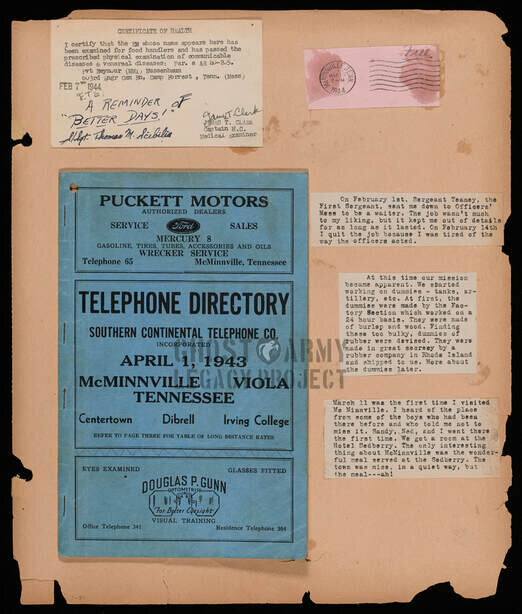Scrapbook 1
Seymour Nussenbaum: My Life in the Army 2
Scrapbook 1: December 1942 - December 1944
"On January 3, 1944 we received our first indication that we were going to a new camp ... on January 12 we heard definitely that it would be Camp Forrest, Tennessee."
- from Seymour Nussenbaum scrapbook “My Life in the Army”

"June 8 - I went to Washington, D.C. in the evening with Santino Governable, a fellow I met in my company. I saw the Capitol, White House, and the Mellon Art Institute. We also visited the Stage Door Canteen, and took some pictures in front of the Capitol."

On furlough from July 15 to 22, 1943, Nussenbaum took a trip to Bear Mountain in New York's Hudson Highlands, and did some fishing in Sheepshead Bay in Brooklyn.

Nussenbaum was stationed at the bivouac at the 2A area from July 23 to August 9, 1943. "We had dry runs in firing the carbine. ... I made marksman!" Nussenbaum was next moved to another area in Fort Meade. "During the last few months of our stay at Fort Meade, we were members of the Thirteenth Corps, but we were not authorized to wear the patch."

"Sandy, Ned Harris, Paul Popkin, and Myself"

June 25, 1943, Back from Bivouac Nussenbaum is the man wearing the Fort Meade T-shirt in the second row.

Erecting a gin-pole, a supported pole that uses a pulley or block and tackle on its upper end to lift heavy loads

The news article mentions that the 603rd was making a series of full color posters to be used in camouflage training lectures. Around September 1943, Nussenbaum recalls, "I went over the infiltration course, the combat course, the Nazi village, and countless obstacle courses. This was part of a physical education program."

"On January 3, 1944 we received our first indication that we were going to a new camp ... on January 12 we heard definitely that it would be Camp Forrest, Tennessee."

"Once at Forrest, it took no time at all for me to get the details thrown at me again. K.P. two days after we got there, and trash details for the rest of the week. That weekend, starting January 22, I got a weekend pass to Chattanooga."

"At this time [February 1944] our mission became apparent. We stared working on dummies - tanks, artillery, etc. At first, the dummies were made by the Factory Section which worked on a 24 hour basis. They were made of burlap and wood. Finding these too bulky, dummies of rubber were devised. They were made in great secrecy by a rubber company in Rhode Island and shipped to us."